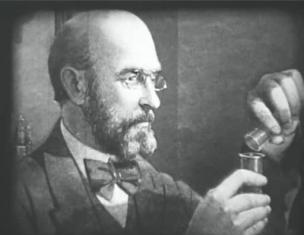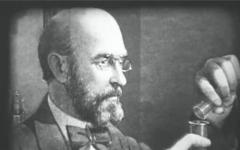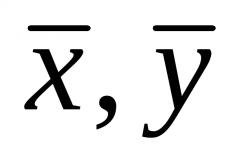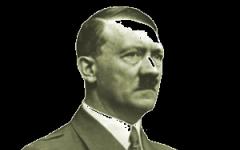Butlerov Alexander Mikhailovich, whose brief biography is found in almost all chemistry textbooks, is a famous Russian chemist, the founder of the scientific school of organic chemistry, the founder of the theory of the structure of organic substances, who predicted and explained the isomerism of a large number of organic compounds and synthesized some of them (urotropine, formaldehyde polymer and etc.). Also, Alexander Mikhailovich, whose contribution to science was highly appreciated by D.I. Mendeleev, wrote works on beekeeping and agriculture.
Butlerov Alexander Mikhailovich: short biography
The future scientist was born on September 15, 1828 in the family of a former military man, at that time a landowner. His father Mikhail Vasilyevich participated in the War of 1812, and after retirement he lived with his family in the family village of Butlerovka. Mom, Sofya Alexandrovna, died at the age of 19, immediately after the birth of her child. Alexander spent his childhood in Butlerovka and his grandfather’s estate - the village of Podlesnaya Shantala, where he was raised by his aunts. At the age of 10, the boy was sent to a private boarding school, where he mastered the French and German languages well. In 1842, after a terrible fire in Kazan, the boarding school was closed, and Sasha was transferred to the 1st Kazan gymnasium. In these educational institutions, Butlerov collected insects and plants, was very interested in chemistry and conducted his first experiments. The result of one of them was an explosion, and Alexander’s punishment for what he had done was imprisonment in a punishment cell with a plaque on his chest reading “The Great Chemist.”
Student years
In 1844, Butlerov A.M., whose biography is permeated with a love of chemistry, became a student at Kazan University, which was at that time a center of natural scientific research. At first, the young man became very interested in zoology and botany, but then his interest, under the influence of lectures by K. K. Klaus and N. N. Zinin, spread to chemistry. On their advice, the young man organized a home laboratory, but the topic of his thesis, perhaps due to Zinin’s move to St. Petersburg, was butterflies.

After graduating from the university in 1849, Alexander Mikhailovich Butlerov, who was petitioned by N.I. Lobachevsky and K.K. Klaus, devoted himself to teaching and lectured on physical geography, physics and chemistry. Moreover, Alexander Mikhailovich was an excellent speaker, able to command the undivided attention of the audience thanks to the clarity and rigor of his presentation. In addition to lectures within the university, Butlerov gave lectures available to the public. The Kazan public sometimes preferred these performances to fashionable theatrical productions. He received his master's degree in 1851, and in the same year he married Nadezhda Mikhailovna Glumilina, the niece of Sergei Timofeevich Aksakov. After 3 years, he defended his doctoral dissertation at Moscow University on the topic “About Essential Oils.” After this, he was elected extraordinary at Kazan University, and a few years later ordinary professor of chemistry. From 1860 to 1863, he was rector twice against his own will, and the rectorship occurred during a rather difficult period in the history of the university: the Kurta memorial service and the Bezdnensky unrest, which affected students and faculty.
Trip to Europe
Alexander Mikhailovich actively participated in the activities of the economic society of the city of Kazan, published articles on agriculture, botany and floriculture. The biography of Alexander Mikhailovich Butlerov includes three trips abroad, the first of which took place in 1857-1858. The Russian scientist visited Europe, where he visited chemical industry enterprises and became acquainted with leading chemical laboratories. In one of them, in Paris, he worked for almost six months. During the same period, Alexander Mikhailovich Butlerov listened to lectures by such outstanding European minds as A. Becquerel, E. Mitscherlich, J. Liebig, R. V. Bunsen, and made acquaintance with Friedrich August Kekule, a German chemist.

Upon returning to Kazan, A.M. Butlerov, whose biography is of interest not only in Russia but also abroad, re-equipped the chemical laboratory and continued the research on methylene derivatives begun by Wurtz. In 1858, the scientist discovered a new method for synthesizing methylene iodide and carried out a number of works related to the extraction of its derivatives. During the synthesis of methylene diacetate, a polymer of formaldehyde was obtained - a saponification product of the substance under study, the result of experiments on which was hexamethylenetetramine and methylenetinate. Thus, Butlerov was the first to produce a complete synthesis of a sugary substance.
Butlerov Alexander Mikhailovich: briefly about the achievements of the scientist
In 1861, Butlerov spoke in Speyer, at the Congress of German Physicians and Naturalists, with a lecture “On the Chemical Structure of Matter,” which was based on his acquaintance with the state of chemistry abroad, an irresistible interest in the fundamentals of chemistry from a theoretical point of view, and his own experiments carried out throughout his scientific career.

His theory, which included ideas about the ability of carbon atoms to form chains by A. Cooper and on the valence of A. Kekule, assumed the chemical structure of molecules, by which the scientist understood the method of connecting atoms with each other depending on a certain amount of chemical force (affinity) inherent in each atom.
Important aspects of Butlerov's theory
The Russian scientist established a close connection between the structure and chemical properties of a complex organic compound, which was able to explain the isomerism of many of them, including three pentanes, two isomeric butanes, and various alcohols. Butlerov’s theory also made it possible to predict possible chemical revolutions and explain them.
Thus, in his theory, Alexander Mikhailovich Butlerov:
- showed the insufficiency of the theories of chemistry that existed at that time;
- emphasized the most important atomicity;
- defined as the distribution of affinity forces belonging to atoms, as a result of which the atoms, exerting an influence on each other (mediocre or direct), combine into a chemical particle;
- identified 8 rules for the formation of chemical compounds;
- was the first to draw attention to the difference in the reactivity of dissimilar compounds, explained by the lower or higher energy with which atoms combine, as well as the incomplete or complete consumption of affinity units when forming a bond.
Scientific achievements of the Russian chemist
The biography of Alexander Mikhailovich Butlerov is briefly described in school textbooks, with the dates of his life and his greatest achievements. The Russian scientist has a huge number of experiments aimed at confirming his theory. The scientist, having previously synthesized, determined in 1864 the structure of tertiary in 1866 - isobutane, in 1867 - isobutylene. He also learned the structure of a number of ethylene carbons and polymerized them.

In 1867-1868 Butlerov Alexander Mikhailovich, whose short biography evokes scientists all over the world, was appointed professor of chemistry at St. Petersburg University. Introducing him to the staff of this institution, Mendeleev emphasized the originality of Butlerov’s teaching, which was not a continuation of anyone else’s work, but belonged to him personally.
In 1869, Butlerov finally settled in St. Petersburg, where he was elected extraordinary and then ordinary academician of the St. Petersburg Academy of Sciences. The period of his life in St. Petersburg was very active: the professor continued his experiments, polished the theory of chemical structure, and participated in public life.
Hobbies in the life of a scientist
In 1873, he began studying and gave lectures on this topic. He wrote the first manual in scientific history based on the theory of chemical structure - “An Introduction to the Complete Study of Organic Chemistry.” Alexander Mikhailovich Butlerov is the founder of the school of Russian chemists, otherwise called the “Butlerov school.” In parallel with the study of chemistry, he was actively interested in agriculture. In particular, he was interested in growing tea in the Caucasus, gardening and beekeeping. His brochures “How to Keep Bees” and “The Bee, Its Life and the Main Rules of Intelligent Beekeeping” were reprinted many times, and in 1886 he founded the magazine “Russian Beekeeping List”.
In 1880-1883 Butlerov Alexander Mikhailovich, whose short biography is interesting and replete with important discoveries for science, was the president of the Russian Physical and Technical Society. During the same period, the scientist became very interested in spiritualism, which he met at the Aksakov estate in 1854. Later he became close friends with his wife’s cousin A.N. Aksakov, who published the journal on spiritualism “Psychical Research,” and passionately defended his passion to his acquaintances and friends who condemned him.
The value of the works of Alexander Mikhailovich Butlerov for chemistry
Alexander Mikhailovich was supposed to retire in 1875, after 25 years of service. The Council of St. Petersburg University twice extended this period by 5 years. The last lecture of Alexander Mikhailovich Butlerov took place on March 14, 1885. His health failed, undermined by intensive scientific work and social activities: unexpectedly for everyone, Butlerov died on his estate on August 5, 1886. The scientist was buried in the rural cemetery of his native Butlerovka, now defunct, in the family chapel.

Butlerov’s works received worldwide recognition during his lifetime; his scientific school is considered an integral component of the development of chemistry in Russia, and the biography of Alexander Mikhailovich Butlerov arouses genuine interest among scientists and students. Alexander Mikhailovich himself was a very charming and versatile person with a sociable character, open-mindedness, good nature and a condescending attitude towards his students.
The life and work of Butlerov, a Russian chemist, academician of the St. Petersburg Academy of Sciences and professor at St. Petersburg University, creator of the theory of chemical structure, is described in this report about the scientist. You can supplement the report on Butlerov.
Butlerov a short message
A short message about his life and work should begin with the fact that he was born on September 15, 1828 in the town of Chistopol into a family of nobles. In 1844 he entered Kazan University, after which his successful scientific career began. 8 years after graduating from the university, Alexander Mikhailovich becomes an ordinary professor and is sent on a business trip abroad. The scientist visited Germany, Switzerland, Italy, France, England and the Czech Republic, meeting Western chemists.
It is worth noting that after defending his master’s thesis, Alexander Mikhailovich married Nadezhda Mikhailovna Glumilina, with whom he lived for more than 30 years. The couple had two sons.
Returning home, he began re-equipping his chemical laboratory and carrying out a series of experimental works. In 1861 he developed a theory of chemical structure. What did Butlerov mean by the chemical structure of a substance? The scientist called this a certain order in which atoms are combined into molecules using chemical bonds.
3 years later, the chemist publishes the world's first manual, a monograph entitled “An Introduction to the Complete Study of Organic Chemistry,” which had a strong influence on the development of chemical science in the world. Having moved to St. Petersburg in 1869, Butlerov began giving lectures on chemistry.
Fighting for women to have the opportunity to receive higher education, he gives public lectures at the Vladimir, St. Petersburg and Bestuzhev women's courses.
The great Russian chemist died in the village of Butlerovka, Kazan province, on August 17, 1886, in the arms of his wife.
What is the scientist’s contribution to beekeeping?
In addition to chemistry, Butlerov was engaged in beekeeping. He published a paper on the topic "Two Fallacies" in 1870, for which he was awarded a gold medal. Also, his hand belongs to the treatise “The Bee, Its Life and the Main Rules of Intelligent Beekeeping.” Butlerov longed to expand knowledge about bees among the entire population. The scientist even proposed to include beekeeping in the list of seminary subjects and advocated the thematic free distribution of various publications for soldier seminaries and schools. In addition, Butlerov created his own school for the development and conduct of beekeeping. He himself had a large apiary at home.
Interesting facts from the life of Butlerov:
- He was interested in the issues of breeding tea varieties in the Caucasus.
- In his declining years, the chemist became interested in spiritualism.
- Butlerov brought out a new variety of roses.
- Loved hunting.
- Using the knowledge received from his father, Alexander Mikhailovich treated people and animals.
We hope that the report on Butlerov helped you in preparing for classes. And you can leave your story about Alexander Butlerov using the comment form below.
Butlerov first taught, as Zinin had once recommended to him, on the basis of Gerard’s theory of types. Then he moved on to carbon types, which in their idea are close to Dumas’ mechanical types, and finally, in the 1860-1861 academic year, he began to teach a course based on the theory of chemical structure. The transition from old theories to the theory of chemical structure was facilitated by the fact that in 1860 a congress of chemists took place in Karlsruhe, at which the concepts of atom and molecule were formulated and it was recommended to use atomic formulas in the future, and not formulas with signs corresponding to equivalents.
On September 19, 1861, at the congress of German doctors and natural scientists held in Speyer, A.M. Butlerov read a report “On the chemical structure of substances”
The essence of the report can be stated as follows: Butlerov proposes to abandon the theory of types in all its varieties; talks about what should be meant by chemical structure; expresses the main position of the theory of chemical structure, which distinguishes it from all previous views; outlines ways to determine the structure; speaks out about the form and content of chemical structure formulas.
The basic principles and concepts of the theory of chemical structure form a coherent logical system, without which the work of a modern organic chemist is unthinkable.
This system includes the following provisions:
atoms in molecules are connected to each other in pairs by chemical bonds in accordance with their valency;
molecules have a certain order (or sequence) in the distribution of bonds between atoms, i.e., a certain chemical structure;
the properties of chemical compounds depend on the chemical structure of their molecules; A number of conclusions follow from this situation:
a) by studying the properties of substances, one can get an idea of their chemical structure, and knowing the chemical structure of even substances that have not yet been obtained, one can predict what properties they will have;
b) the cause of isomerism is the difference in the chemical structure of substances having the same composition;
c) chemical structure formulas also give an idea of the properties of compounds;
atoms in molecules influence each other; this influence does not equally affect the properties of atoms of the same elements if the chemical structure of the molecules is different.
Literature:
1. Bykov G.V. A.M. Butlerov. – M.: Education, 1978.- 93 p.
2. Volkov V.A. Outstanding chemists of the world. (edited by V.I. Kuznetsov. - M.: Higher School, 1991.)
3. General history of chemistry. History of classical organic chemistry. – M.: Nauka, 1992.
4. V. Malyshkina Entertaining chemistry. – St. Petersburg, Trigon, 2001.
5. Soloviev Yu.I. History of chemistry. – M.: Education, 1983 – 336 p.
6. Figurovsky N.A. History of chemistry. – M.: Education, 1979 – 311 p.
7. Strube V. Ways of development of chemistry. in 2 volumes. Volume 1 From primitive times to the industrial revolution. Per. with him. – M.: Mir, 1984.- 239 p.
8. I’m going to a chemistry lesson: Chronicle of the most important discoveries in chemistry of the 17th-19th centuries: Book. for the teacher. – M.: First September, 1999. – 320 p.
9. Lectures.
10. Materials from the Internet.
Russian chemist, creator of the theory of chemical structure and the first Russian school of chemists.
He lost his mother early and from the age of 8 was raised in Topornin’s private boarding school in Kazan.
“Little Butlerov, like all bards, had an uncle. The boy had no idea about chemistry, but he loved fireworks and he liked chemical glassware. The man easily supplied him with the substances and utensils needed to prepare fireworks, and the child enthusiastically indulged in experiments. He mixed sulfur, saltpeter, coal and got gunpowder; he dissolved copper sulfate in a flask and, dipping an iron nail into the blue liquid, saw how it was covered with copper. The boy was not interested in the practical results of the miracles he performed. His imagination was occupied by the process of transformation of substances.
An interesting episode, later told by his boarding house comrade Shevlyakov, dates back to this period of Butlerov’s life:
“Butlerov was diligently fiddling with some flasks, jars, funnels, mysteriously pouring something from one bottle to another. The restless teacher Roland disturbed him in every possible way, often taking away flasks and vials, putting him in a corner or leaving the uninvited chemist without lunch, but he did not let up, taking advantage of the patronage of the physics teacher. Eventually, in the corner, near Butlerov’s bed, a tiny, always locked cabinet filled with some kind of drugs appeared.
One fine spring evening, when the pupils were peacefully and cheerfully playing rounders in the spacious yard, and “frantic Roland” was dozing in the sunny sun, a deafening explosion was heard in the kitchen... Everyone gasped, and Roland, with a tiger’s leap, found himself in the basement where the kitchen. Then the “tiger” appeared in front of us again, mercilessly dragging Butlerov with singed hair and eyebrows, and behind him, with his head hanging, walked a guy brought in as an accomplice, secretly delivering the materials necessary for carrying out the experiments.
To the credit of the Topornin boarding house, it should be noted that rods were never used in this
institution, but since Butlerov’s crime was out of the ordinary, our teachers, at a general council, came up with a new, unprecedented punishment. Two or three times, the criminals were taken out of the dark punishment cell into the common dining room, with a black board on their chest, on the board there was the words “Great Chemist” in large white letters.”
Student A.M. Butlerova - S.V. Lebedev, creator of an industrial method for producing synthetic rubber.








